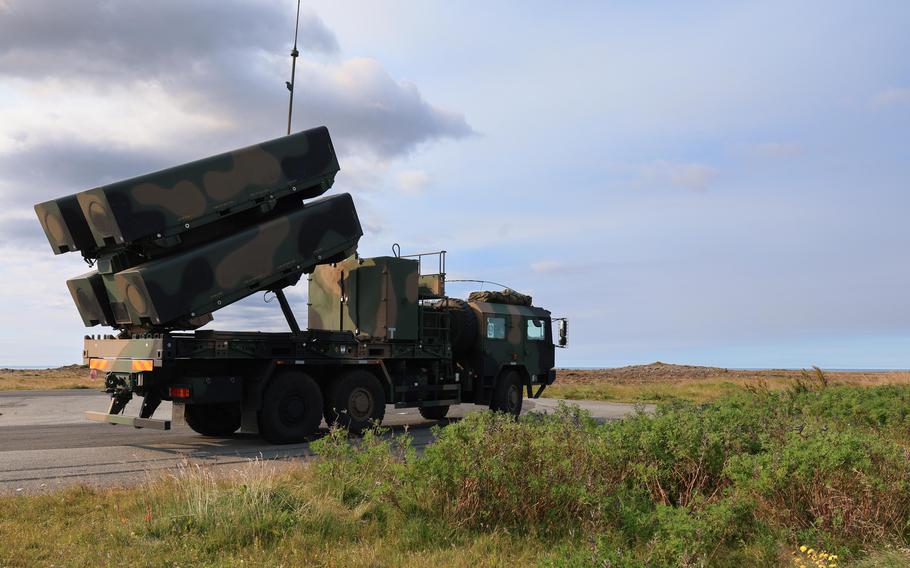
A Naval Strike Missile mobile launch vehicle is in raised firing position during exercise Northern Viking at Keflavik Air Base, Iceland, on Aug. 26, 2024. (Almagissel Schuring/U.S. Navy)
KEFLAVIK, Iceland — A demonstration of Poland’s military prowess far from its shores offers an important advantage in the northern Atlantic as the U.S. and NATO build up defenses in a region of major interest to Russia, defense officials said.
The U.S.-led Northern Viking exercise included Polish navy missiles and a launching system, which were transported some 1,600 miles to Iceland.
That arduous undertaking is notable as Poland broadens its capabilities beyond its “backyard” to enhance allied defense of the Arctic and the northern Atlantic Ocean, said Cmdr. Richard Betancourt, director of training and exercises for U.S. Naval Forces Europe-Africa.
The Polish team’s integration with U.S. Navy P-8 Poseidon patrol and reconnaissance aircraft and Allied Maritime Command happened as the former Warsaw Pact country “becomes a major player in NATO,” said Betancourt, who directed the nine-day exercise, which ended Tuesday.
That interaction was noteworthy in that it was the first time Poland had coordinated with the U.S. Navy and Marine Corps on the Naval Strike Missile system, Polish military officials said.
The exercise helped to increase the Polish battery’s deployment range to nearly worldwide, said Polish navy Cmdr. Marcin Brudniewicz, commander of the NSM Battery Task Unit.
The missile system was in Iceland only for the exercise, which did not include any live firing of missiles.
Denmark, France, Iceland and Norway as well as components of Standing NATO Maritime Group 1 also participated in Northern Viking.
The biannual exercise included training in search and rescue, sustainment and mass casualty response, among other activities.
Russian aggression in Europe, including the illegal annexation of Crimea in 2014 and the full-scale invasion of Ukraine in 2022, has energized a Cold War-like sensibility among NATO nations in defending not only the Continent but also the Arctic.
The region, including a narrow maritime choke point separating the Atlantic from the Norwegian and North seas often referred to as the GIUK gap, factors as a key consideration in U.S. homeland defense, said Capt. Geoffrey Townsend, commodore of Task Force 68, based in Rota, Spain.
The shore-based, anti-ship missile system allows for allied power projection into the Baltic Sea “that somewhat matches what Russia has from Kaliningrad,” Townsend said.
That makes it a useful tool in a Russian aggression scenario should the alliance need to work its way back into the Baltic states, he said.
Known for its low-altitude flying capability and high accuracy, the subsonic Naval Strike Missile has a range of about 114 miles. There also is a sea-based variation.
The missile is used by the Navy and Marines as well as the armed forces of Germany, Romania, Spain and other countries, according to its Norwegian manufacturer, Kongsberg.
On Saturday, the crew of a P-8 Poseidon flying over the north Atlantic worked with the ashore Polish missile battery to identify, assess and target potential enemy vessels in a coastal defense simulation.
The work included transmitting vessel location data from the aircraft to the Polish battery to complete a simulated strike. A support team from the U.S. Marines 2nd Air-Naval Gunfire Liaison Company, or 2nd ANGLICO, helped coordinate communications between the battery, the P-8 and a command center.
“If we had to ever come up on a mission set like this in real life, it builds my confidence,” one naval airman aboard the Poseidon said of working with the Polish team. “They’ve been spot-on.”
Navy officials asked Stars and Stripes not to name the participating air crew because of the sensitivity of their operations and concerns for their safety.
During the exercise, Marines worked to bridge communications for the Polish battery, whose own digital systems have not been NATO-certified yet, said Capt. Maggie Valcourt, 2nd ANGLICO Supporting Arms Liaison Team C lead.
Witnessing the Polish battery’s competence with the Naval Strike Missile system and techniques used during operations was a good learning experience for Valcourt and other Marines, she said.
Those lessons will be important as the Marine Corps works to enable its own missile strikes at sea, Valcourt said.
“It’s going to be huge,” she said.